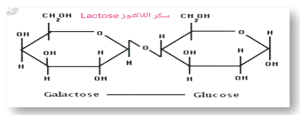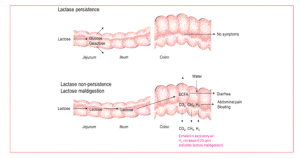Prof.D.zainab hadi abbas alaameri
College of Agriculture
Department of Animal Production
Lactase, the sugar in milk, cannot be digested properly when there is insufficient lactase production in the small intestine of those who are lactose intolerant (lactose). Lactase is the enzyme that converts galactose into glucose and galactose under normal conditions. These sugars are then absorbed into the bloodstream through the lining of the intestine. (2) If you do not have enough lactase in your body, the lactose in the food you eat will be passed through your colon rather than broken down and absorbed. The response of normal bacteria in the colon with undigested lactose is what causes lactose intolerance, and the symptoms of lactose intolerance are what people experience as a result of this reaction. (3)
Lactose intolerance happens when the body doesn’t make enough of the lactase enzyme to break down the lactose in food. It takes between 30 and 120 minutes after consuming milk or milk products for symptoms such as nausea, cramping, gas, flatulence, and diarrhoea to manifest themselves (4). The amount of lactose that a given individual is able to tolerate directly influences the intensity of symptoms, which can vary greatly from person to person (5). Some people are able to develop lactose intolerance after consuming only a trace amount of lactose in food, while others don’t experience any symptoms until they consume a significant amount (6).
Both a person’s age and the rate at which they digest food can have an influence on their capacity to tolerate lactose. There are still several aspects of lactose intolerance that need further investigation. This is also the case for a number of digestive diseases, such as Crohn’s disease, ulcerative colitis, celiac sprue (an inherited disorder that affects the lining of the small intestine), other inflammatory bowel diseases, and traumatic or injection-related injuries of the small intestine. Injection-related injuries of the small intestine are a common cause of Crohn’s disease (7). the amount of lactase enzyme that must be present during surgery in order to properly digest lactose in order for the procedure to be successful. If the small intestine is harmed, a transient condition known as lactose intolerance may emerge. However, the symptoms of lactose intolerance may go away once the small intestine has recovered. (8)
The symptoms of lactose intolerance appear in most people gradually when the secretion of the enzyme lactase decreases. This disease affects some races and ethnicities more than others. For example, 80 per cent of African Americans, Middle Easterners, Arabs, Mexicans, and Native Americans suffer from this condition. In addition, 90 per cent of Asians suffer from lactose intolerance. (9).
Discover the three different forms of lactose intolerance. Each form is characterized by its own unique constellation of risk factors for developing lactase deficiency. (10)
*Demonstrates a primary intolerance to lactose.
*Demonstrates a secondary intolerance to lactose.
*There is evidence of either congenital or developing lactose intolerance.
It is conceivable for infants to be born with lactose intolerance due to a lactase deficit; however, this is a very rare occurrence. The condition is more common in older people. This ailment is an autosomal recessive disorder, which means that in order for the child to be afflicted by it, both the mother and the father need to pass on the same genetic mutation. If only one parent does so, the child will not be affected. A genetic pattern known as an autosomal dominant disorder is responsible for the transmission of the condition from one generation to the next (11).
Referens
1-American Academy of Pediatrics, Committee on Nutrition. The practical significance of lactose intolerance in children. Pediatrics. 1978;62:240–245.
2-National Digestive Diseases Information Clearinghouse. Lactose intolerance. Available at: http://digestive.niddk.nih.gov/ddiseases/pubs/lactoseintolerance. Accessed August 18, 2005.
3- Ségurel L, Bon C. On the evolution of lactase persistence in humans. Annu Rev Genomics Hum Genet 2017;18:297-319.
4- Bayless TM, Brown E, Paige DM. Lactase non-persistence and lactose intolerance.Curr Gastroenterol Rep 2017;19:23..
5- Silanikove N, Leitner G, Merin U. The Interrelationships between lactose intolerance and the modern dairy industry: global perspectives in evolutional and historical backgrounds. Nutrients 2015;7:7312–31.
6- Slupsky CM, He X, Hernell O, et al. Postprandial metabolic response of breast-fed
infants and infants fed lactose-free vs regular infant formula: A randomized controlled
trial. Sci Rep 2017;7:3640.
7- Grenov B, Briend A, Sangild PT, et al. Undernourished children and milk lactose. Food Nutr Bull 2016;37:85–99.
8- Amiri M, Diekmann L, von Köckritz-Blickwede M, et al. The diverse forms of lactose intolerance and the putative linkage to several cancers. Nutrients 2015;7:7209–30.
9- Chen L, Tuo B, Dong H. Regulation of intestinal glucose absorption by ion channelsShaukat A, Levitt MD, Taylor BC, et al. Systematic review: effective management strategies for lactose intolerance. Ann Intern Med 2010;152:797–803.
10- Deng Y, Misselwitz B, Dai N, et al. Lactose intolerance in adults: biological mechanism and dietary management. Nutrients 2015;7:8020–35.
11- Hu Y, Gui L, Chang J, et al. The incidence of infants with rotavirus enteritis combined with lactose intolerance. Pak J Pharm Sci 2016;29(1 Suppl):321.































































